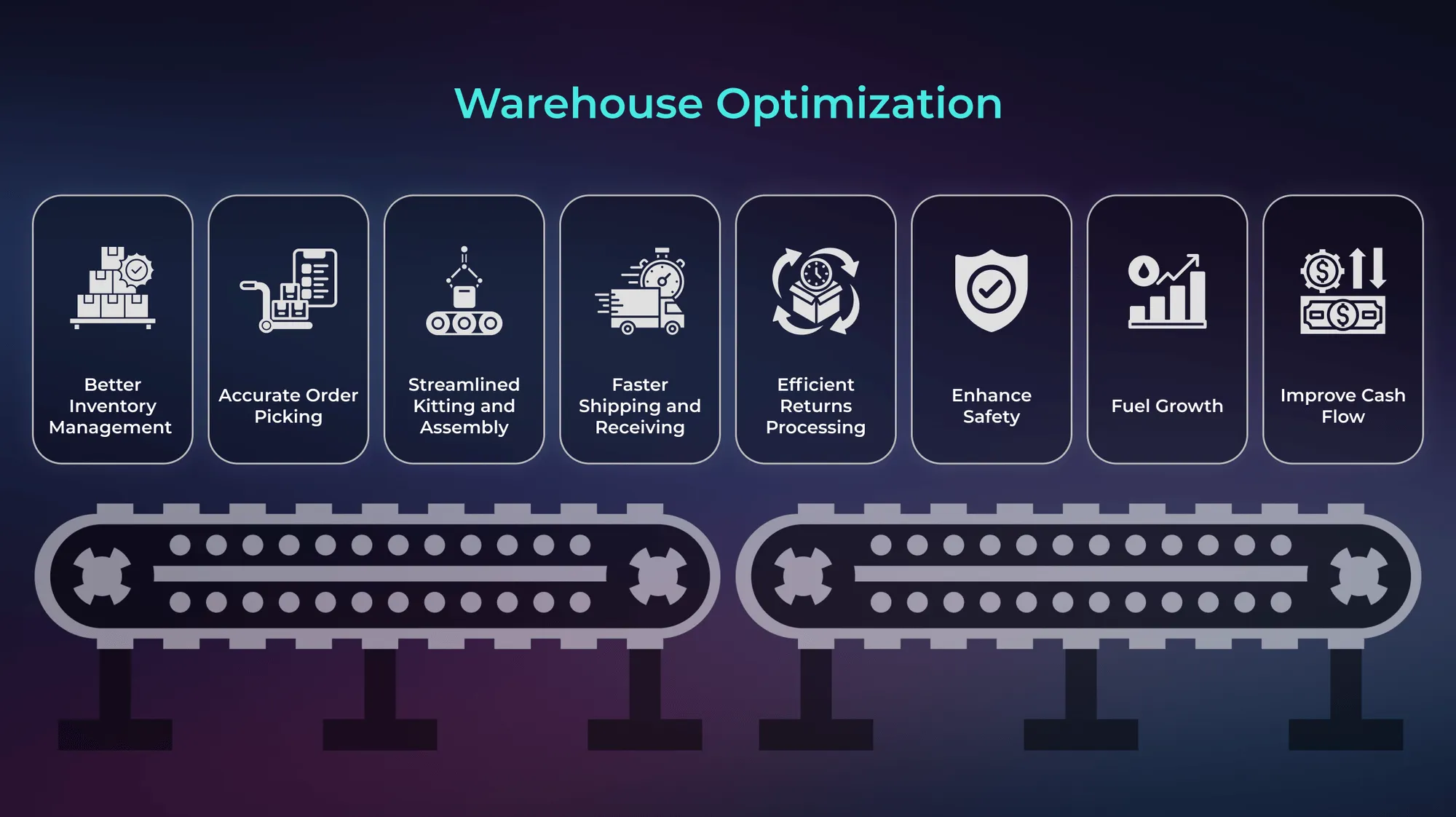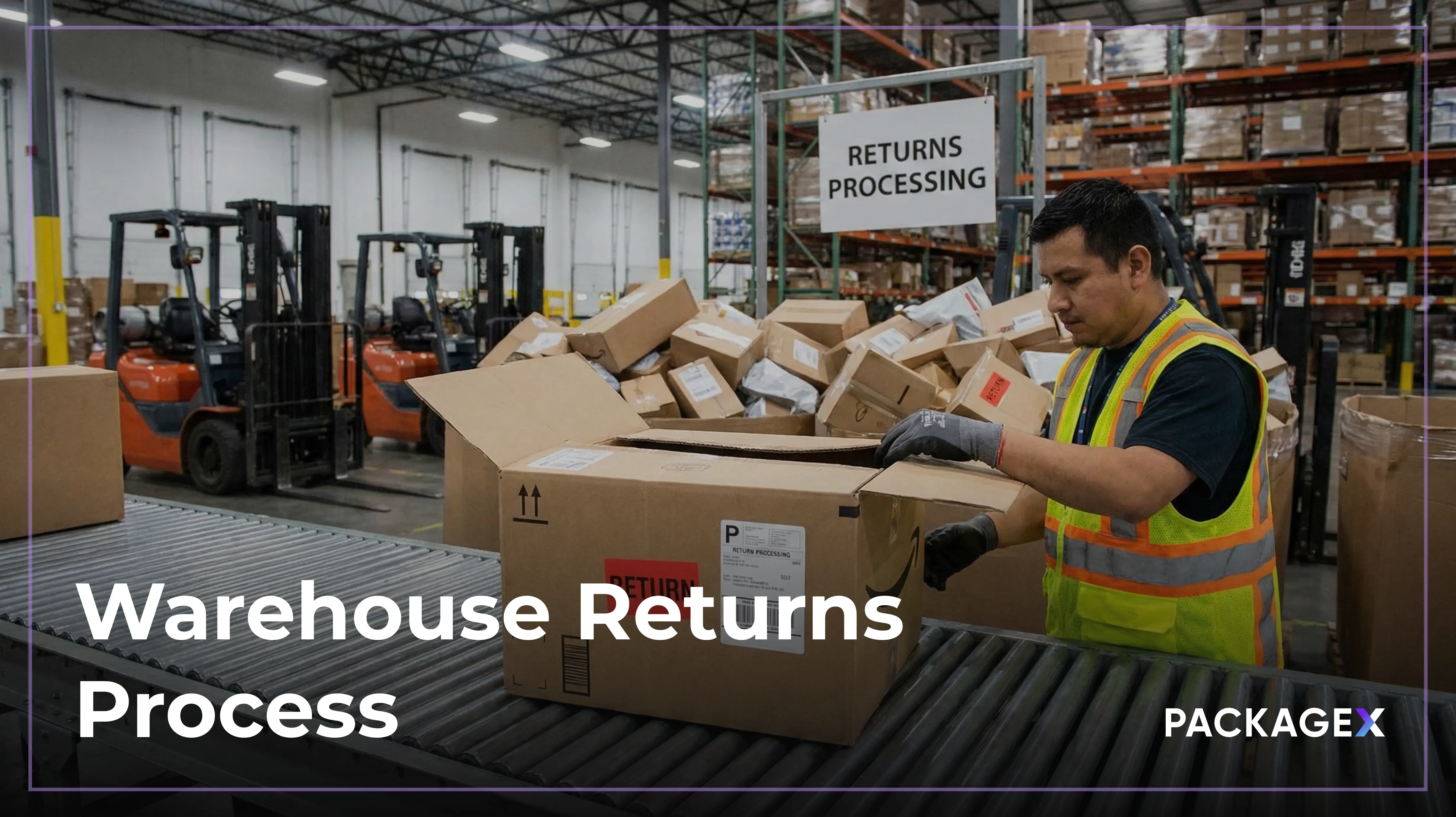Warehouse operations are becoming more complex yet more critical to overall business success. With rising consumer expectations and tighter delivery windows, efficiency is essential to gain a competitive edge.
In this landscape, the role of warehouse optimization has become increasingly strategic. Businesses are investing in smarter systems, automated workflows, and data-driven processes to stay ahead.
In fact, the global warehouse management system market is projected to reach USD 10.17 billion by 2030, growing at a CAGR of 16.4%. This rapid growth reflects a clear growth. Warehouse optimization is now central to how warehouses operate.
These changes are deeply connected to the broader supply chain operations. Understanding what is supply chain and how your warehouse fits into it is essential. A well-optimized warehouse supports accuracy, speed, and cost control across the entire logistics flow.
In the sections ahead, we’ll break down the warehouse optimization meaning, explore proven strategies, and share ideas to improve performance on the ground.
What is Warehouse Optimization?
Warehouse optimization is the process of making your warehouse more efficient. It means improving space, reducing waste, and speeding up operations. This helps cut costs and increase productivity.
It plays a key role in both warehouse management and supply chain operations. A well-optimized warehouse supports the full flow of goods. That’s where supply chain management comes in. It connects inventory, storage, and delivery.
The warehouse optimization process often starts with analyzing how things currently work. From there, you identify delays, errors, or wasted space. Small changes in layout, picking, and packing can make a big impact.
Some companies use a warehouse optimization algorithm to guide decisions. These tools help plan storage, improve picking routes, and assign labor more efficiently.
In short, warehouse optimization means getting the most out of your people, space, and systems.
Key Aspects of Warehouse Optimization
Warehouse optimization improves operations by boosting speed, space use, and accuracy. It focuses on five core areas.
1. Warehouse Layout and Design:
Smart warehouse layout optimization reduces travel time and avoids congestion. Group fast-moving items together and place storage racks for easy access. This boosts space utilization and streamlines workflows.
2. Inventory Management:
Accurate inventory management is key to fast, error-free fulfillment. Real-time inventory systems and FIFO methods reduce waste. Use strong inventory control tools to monitor levels and cut delays.
3. Workflow Optimization:
Optimize steps like receiving, picking, packing, and shipping. Lean methods and better layout reduce bottlenecks. Use order picking strategies to speed up fulfillment.
4. Technology Integration:
WMS (warehouse management systems), barcode scanners, and automation tools improve accuracy. Warehouse optimization software helps spot trends and manage space and labor.
5. Labor Management:
Track staff productivity and schedule shifts based on demand. 3PL service providers can offer scalable labor for peak times.
Why Is Warehouse Optimization Important?
Warehouse optimization helps streamline operations and improve performance. Key benefits include:
- Higher productivity through efficient workflows and layout optimization.
- Better order accuracy with improved pick and pack fulfillment.
- Better inventory management with fewer errors.
- Faster fulfillment using logistics automation and warehouse optimization tools.
- Reduced errors and delays across the warehouse optimization process.
- Greater customer satisfaction and stronger supply chain performance.
Key Benefits of Warehouse Optimization
An optimized warehouse can provide many benefits. From reducing costs to improving tracking, here’s how it helps your bottom line.
1. Reduced Costs:
- Trim labor, storage, and transport expenses with better workflows.
- Use data from your warehouse inventory system to cut waste and avoid overstock.
- Smarter space use means lower overhead.
2. Faster Order Fulfillment:
- Streamline pick-pack-ship with optimized paths and processes.
- Meet customer expectations with quicker turnaround times.
- Ideal for fast-moving 3PL industry operations.
3. Space Savings:
- Make every inch count with better slotting and layout.
- Store more without expanding your footprint.
- Free up room for new products or services.
4. Better Inventory Tracking:
- Real-time inventory tracking keeps you in control.
- Know what’s in stock, what’s low, and what’s moving.
- Avoid stockouts and overstock with smarter planning.
5. Improved Inventory Accuracy:
- Fewer errors in picking and packing.
- Integrated systems boost inventory management across channels.
- Reduced returns and higher customer trust.
6. Enhanced Visibility:
- Track everything: products, processes, and performance.
- A solid warehouse inventory system gives clear insight.
- Make faster decisions based on real-time data.
Types of Warehouse Optimization and Their Challenges
Understanding the different types of warehouse optimization reveals key benefits and the hidden challenges that come with them:
- Warehouse Space Optimization:
Optimizing warehouse racking improves flow and cuts costs. But overcrowding can create chaos and reduce efficiency. - Labor Optimization:
Training and ergonomic design enhance productivity. Yet high turnover remains one of the biggest warehouse optimization problems, increasing both time and cost. - Inventory Optimization:
Balance is critical. Overstocking leads to obsolescence and financial waste, while understocking affects order fulfillment. - Warehouse Storage Optimization:
Strategic stock placement boosts speed and safety. Disorganization, on the other hand, slows down operations and increases the risk of damage. - Technological Optimization: Outdated systems can bottleneck growth. Embracing warehouse optimization software and WMS solutions improves speed, accuracy, and scalability.
Strategic Areas to Optimize Your Warehouse
Warehouse Layout and Space Utilization:
A smart layout is the backbone of any warehouse.
- Start with warehouse layout optimization to reduce travel time and boost flow.
- Use narrow aisle widths and clear slotting systems to improve space utilization.
- Apply warehouse space optimization to store more in less space.
- Follow FIFO inventory valuation to keep products moving and fresh.
- Combine warehouse layout planning with warehouse storage optimization to cut clutter and increase speed.
Inventory Management and Control:
Strong inventory control prevents chaos.
- Define goals clearly, start with a solid inventory management definition.
- Use tech-backed inventory monitoring systems for real-time visibility.
- Balance accuracy with ease using a periodic stock system.
- Upgrade to modern inventory management technology for smarter control.
- Whether in-house or outsourced, choose inventory management services that align with your needs.
- The right inventory system helps scale while cutting waste in management inventory.
Picking and Packing Efficiency:
Picking errors cost time and money. They need to be fixed fast..
- Improve order picking with proven methods like batch or zone picking.
- Adopt warehouse picking optimization to cut steps and errors.
- Integrate your WMS system to automate tasks and guide teams.
- Use warehouse optimization tools and a smart WMS system to speed up fulfillment.
- Small changes in warehouse optimization techniques can lead to big gains.
Technology & Automation:
Tech is no longer optional. It’s essential.
- Use a WMS warehouse management system to control everything from stock to shipping.
- Pair that with warehouse optimization software for real-time updates.
- Add RFID or barcode systems to increase speed and reduce mistakes.
- A WMS warehouse setup improves visibility, while warehouse optimization solutions boost efficiency.
- All of this ties into one core driver: real-time inventory powered by smart systems.
Labor Productivity and Workflow Design:
People are your biggest asset. Make every move count.
- Launch a warehouse optimization project focused on lean methods and ergonomic setups.
- Cross-train workers to boost flexibility.
- A trusted 3PL provider or 3PL service provider can help during high demand.
- Design workflows that align with your chain management system.
- Optimize both the supply chain management and execution to improve speed and reduce fatigue.
Common Mistakes to Avoid
Even optimized warehouses can fail without the right balance. Here are some common mistakes to look out for:
- Over-dependence on automation:
Relying too much on automation without a strategy can create inefficiencies. - Skipping warehouse layout updates:
Ignoring layout redesign slows operations, even with the best systems. - Outdated WMS system:
Running an old WMS system limits tracking, speed, and accuracy. - Short-term fixes over real solutions:
Quick wins often backfire; invest in long-term warehouse optimization solutions.
Latest Trends in Warehouse Optimization
Modern warehouse optimization strategies are evolving fast due to shifting demands. Key trends include:
- Flexible Warehouse Layout Optimization:
Flex design allows temporary space expansion for seasonal needs, enhancing warehouse space optimization and inventory control. - IoT and Real-Time Inventory Tracking:
Smart sensors and connected devices power real-time inventory visibility, improving the inventory monitoring system and reducing stock discrepancies. - AI and Robotics in Warehouse Picking:
Automated systems powered by warehouse optimization algorithms accelerate warehouse picking optimization, reduce errors, and improve throughput. - WMS Integration and Automation:
Advanced WMS warehouse platforms connect inventory, space, and labor for streamlined operations and scalable warehouse optimization solutions. - Big Data and Predictive Analytics:
Analytics tools forecast demand, optimize stock levels, and support smarter inventory management decisions.
These trends collectively enhance warehouse operations and support long-term growth.
How PackageX Supports Warehouse Optimization?
PackageX helps warehouse teams simplify and streamline their operations. PackageX’s AI-powered tools bring clarity and control to every step of the warehouse optimization process.
Here’s how PackageX can support your team:
- Seamless APIs for optimization that integrate with your existing systems.
- Real-time inventory tracking to boost accuracy and reduce fulfillment delays.
- Smarter warehouse picking optimization with improved flow and fewer touchpoints.
- Easy-to-deploy tools for warehouse layout optimization and space utilization.
Ready to start your warehouse optimization process?
Book a demo today and see how PackageX makes it simple.
FAQs
How to optimize space in a warehouse?
To optimize warehouse space, use smart slotting strategies, vertical racking, and narrow aisles. A well-planned warehouse layout maximizes capacity without expanding the footprint.
What are the 5 warehouse processes?
The five core warehouse processes are receiving, put-away, picking, packing, and shipping. Optimizing these steps improves accuracy, speeds up fulfillment, and enhances overall warehouse efficiency.
How to optimize warehouse layout?
Start with warehouse layout optimization by analyzing traffic flow, placing fast-moving items up front, and minimizing travel time. A smart layout improves both space utilization and workflow.




